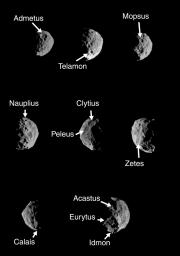
|
Phoebian Explorers 2
- Click the image above for a larger view
- Full-Res JPEG (1303 x 1850) (100.6 kB)
- Full-Res TIFF (1303 x 1850) (403.6 kB)
Caption:
These two montages of images of Saturn's moon Phoebe, taken by Cassini in June 2004, show the names provisionally assigned to 24 craters on this Saturnian satellite by the International Astronomical Union.
The craters are named for the Argonauts, explorers of Greek mythology who sought the golden fleece. Argo was the name of their ship. The largest crater, approximately 100 kilometers (62 miles) across, is named after the leading Argonaut, Jason. Phoebe is an outer moon of Saturn and is 220 kilometers (136 miles) across.
The two-image montage PIA06117 displays mosaics made of individual, very high resolution images: 80 meters (260 feet) per pixel on the left; 200 meters (660 feet) per pixel on the right.
This montage shows eight images of much lower resolution, ranging from 0.5 to 1 kilometer (0.3 to 0.6 mile) per pixel. The images in this montage show Phoebe as it rotated, and include regions of the moon not visible in the higher resolution montage.
The images have been slightly rescaled from their original formats and contrast-enhanced.
Background Info:
The Cassini-Huygens mission is a cooperative project of NASA, the European Space Agency and the Italian Space Agency. The Jet Propulsion Laboratory, a division of the California Institute of Technology in Pasadena, manages the mission for NASA's Science Mission Directorate, Washington, D.C. The Cassini orbiter and its two onboard cameras were designed, developed and assembled at JPL. The imaging team is based at the Space Science Institute, Boulder, Colo.
For more information about the Cassini-Huygens mission, visit http://saturn.jpl.nasa.gov and the Cassini imaging team home page, http://ciclops.org .
Cataloging Keywords:
| Name | Value | Additional Values |
|---|---|---|
| Target | Phoebe | Saturn |
| System | Saturn | |
| Target Type | Satellite | Irregular, Planet |
| Mission | Cassini-Huygens | |
| Instrument Host | Cassini Orbiter | |
| Host Type | Orbiter | |
| Instrument | Imaging Science Subsystem (ISS) | |
| Detector | ||
| Extra Keywords | Crater, Grayscale, Rotation | |
| Acquisition Date | ||
| Release Date | 2005-02-24 | |
| Date in Caption | ||
| Image Credit | NASA/JPL/Space Science Institute | |
| Source | photojournal.jpl.nasa.gov/catalog/PIA06118 | |
| Identifier | PIA06118 | |
